Q&A – Ask Neil: November 10, 2022
(Please read these instructions carefully.)
Before you post your question, please look at recent issues to see if someone else has already asked it. You might find your answer there.
How to submit your question…
• Click here to post your question.
• After you submit your question, a new window will pop up giving you the address to which you can e-mail a photo to accompany your question. Clear, medium-resolution photos. (Try to avoid low-res thumbnail photos, please, in case I have to zoom in to see things.)
• Please only post your question one time.
• One question per reader, please.
• Please use this only for posting questions – not for standard emails.
• Watch for your answer in the following week’s e-gardens.
• I choose those of greatest general interest. For example, plant IDs seldom make the cut.
• I must have your first name or initials.
• I must have your city or county. (Texas is a very large state.)
QUESTION 1
HOW GOOD ARE MIMOSA TREES?
Question: We are building a home on about 4 acres in Van Alstyne. My husband thinks mimosas are beautiful and would love to plant one, but for some reason I think of them as “junk” trees. Thoughts? Jan W., McKinney.
Answer: (Domestic disagreements. Always the worst kind!) I grew up with a mimosa in our backyard in College Station and I loved it. However, as I matured I learned that they are susceptible to several fatal diseases (cotton root rot, mimosa wilt, etc.) and the messy mimosa webworms. You’ll never see them included in plans done by landscape designers and I can’t remember the last time I saw one sold in a nursery other than the purple-leafed one called ‘Summer Chocolate.’ We live on 11 acres in rural Collin County and my goal for the 45 years that we have been here is to use only trees native to the surroundings. I don’t want my landscape to look like I moved in and brought a bunch of strangers in with me. Closer to the house where I’m landscaping with shrubs it’s a different story, but not so with my trees. (Just one guy’s personal feeling.)
QUESTION 2
SHOULD ELEPHANT EAR TUBERS BE DUG FOR THE WINTER?
Question: I have two elephant ear plants. Should I dig and store the tubers over the winter? If so, when? How should they be stored (medium)? When should they be replanted? David B., Ardmore Co., OK.
Answer: You’ve had enough cold already that you can dig them. Lay them on newspaper for several days to dry, then dust them with fungicide before storing them in dry perlite or sawdust at 60F for the winter. Plant no earlier than mid-April in Ardmore. (They need really warm soils.) You could also try leaving them in the ground and mulching over them with 5-6 inches of leaves. (Hope for a mild winter! No guarantees.)
QUESTION 3
HOW DO WE GET RID OF GRUB WORMS?
Question: Armadillos and moles are tearing up our yard after the rains. Someone has suggested we must have grub worms. How can we eliminate them? Hedda F., Keller.
Answer: You won’t have moles if you have clay soil. (I believe most of Keller has clay.) Armadillos are nocturnal. You can see their snout marks in the top of the ground and you should be able to find their tunnels back under shrubs, perhaps against your foundation. We still have one active in our woods currently and have the Havahart humane trap set to try to capture it. We’ve caught several in the past few months. I’m not a killer. We take them several miles down the road and release them onto Corps of Engineers property adjacent to a lake (away from farmland and homesites). I have never found them to be going after grubs specifically, but you could certainly dig and check for grubs if you wished. You are too late to try to control grubs with insecticides for this season.
QUESTION 4
WHEN IS THE BEST TIME TO DIVIDE FIRECRACKER PLANT?
Question: When is the best time to divide firecracker plant? Susie S., Abilene.
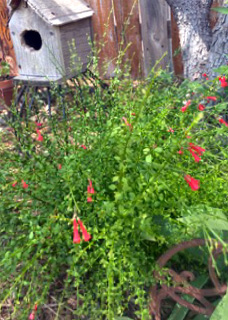
Answer: It isn’t propagated by division, but primarily by cuttings. You’ll find information online about ways to root them, even a few amateur videos on YouTube. It roots fairly easily.
QUESTION 5
HOW DO I CARE FOR MY PASSIONVINE OVER THE WINTER?
Question: I love my passionvine and want to make sure it makes it through the winter. It’s a beautiful purple color. What do I need to do? Phyllis C., McKinney.
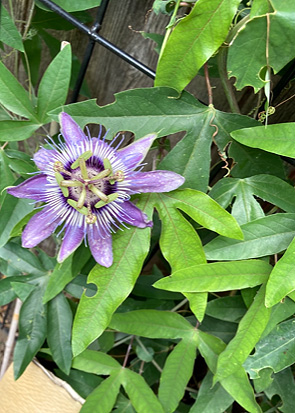
Answer: Keep it bright and warm. A 70-degree greenhouse would be ideal, but most folks don’t have one sitting around the house, so a sunroom window would be good. Or move it into and out of the garage on a plant dolly rigged up to handle the two trellises you mentioned in your longer note. By the way, when I saw your photo I thought you were going to ask about the semi-circular holes in the edges of the leaves. Those are the work of the fascinating and essentially harmless leaf-cutter bees.
QUESTION 6
HOW CAN I ERADICATE GOATHEADS?
Question: After the rain earlier this year goatheads grew a foot tall. How can we get rid of them? M.F., Alpine.
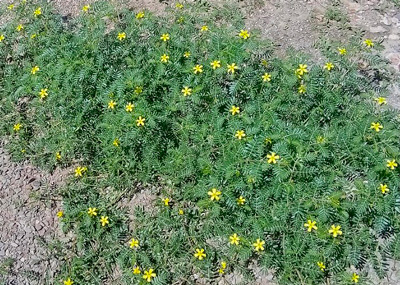
Answer: As opposed to sand burs (grass burs), goatheads are broadleafed plants. As such, the pre-emergent Gallery will prevent their germination. You can also eliminate existing plants once they sprout with a broadleafed weedkiller spray containing 2,4-D. You will have to be very careful in applying that type of spray anywhere near desirable vegetables, shrubs, flowers and groundcovers. Read and follow label directions carefully.
QUESTION 7
ONE TRUNK OF AN OAK BROKE FOLLOWING RAIN. HOW TO SAVE REMAINING ONES.
Question: We lost one-third of a 50-foot oak tree with the rain overnight. How can we save the two remaining trunks? Rita M., Pilot Point.
Answer: (How much help just one photo could be.) You really need to have a certified arborist examine the remaining trunks to be sure they are structurally sound and safe – not likely to fall and cause damage or injury. Look closely for decay that might have been in the old trunk and that could also be developing in the remaining trunks. A lot of the answer will depend on the species of oak. Very tall post oaks are probably near the end of their life spans, while Shumard red oaks are able to go on for decades longer. Live oaks, unless they were damaged by the cold of February 2021 can survive for centuries. As I said, oh, for a photo!
QUESTION 8
DO I NEED TO ACIDIFY WATER WHEN WATERING PLANTS?
Question: My heavy clay soil is slightly acidic (pH 6.8). My irrigation water is very alkaline (9.2). Will this take a while to affect the pH of my soil, or do I need to acidify the water when irrigating acid-loving plants? Heath T., Whitesboro.
Answer: That is extremely alkaline water. But clay soils have so much surface area that you should be fine. If it were my landscape and garden, I would just be careful in trying to plant species that require copious amounts of iron. It becomes insoluble in alkaline conditions. Even if you were to plant in highly organic planting mixes like sphagnum peat, that water would fairly soon overwhelm it. Maybe stay away from azaleas, mophead hydrangeas, dogwoods, camellias, etc. It’s just not practical to try to acidify water on a prolonged basis.
QUESTION 9
OAK IS LOSING BARK. WHY, AND IS THERE HOPE?
Question: My oak tree is losing its bark. The tree is about 50 feet tall. Its leaves turned brown by the end of August, I suspect because of the heat and lack of rain. Is there hope? Bob B., Tarrant Co.
Answer: What species? It sounds like the damage that happened to many live oaks after the cold of February 2021. Called “radial shake,” it caused vertical cracks in the bark. The bark then split and fell away from the trunk. In those cases the trees have struggled to varying degrees. You really need to have a certified arborist look at your tree. It’s worth it. (The advertiser who supports this publication, Arborilogical Services, would be very capable of helping you.)
QUESTION 10
BEST TIME TO PLANT PEONIES AND THEIR LIGHT REQUIREMENTS.
Question: When is the best time to plant peonies and what are their light requirements? Karen B., Fairview, Collin Co.
Answer: They are best planted from roots in mid-fall (by now) or from pots in bud in the spring. Give them full morning sun and light afternoon shade. If you would permit an editorial comment, think about how many peonies you see as you drive around in Collin County (very few). That is a good indication of how well they do (or don’t do) this far south. I have tried them within 10 miles of where you live and they were very challenging. When they did come into bloom they were hit by spring winds and driving rains. They held their blooms for only a few days. Try a limited number first to see if you’re satisfied.
QUESTION 11
WHAT IS WRONG WITH MY DWARF CRAPE MYRTLES?
Question: I have 24 dwarf crape myrtles. They were fine until the cold of February 2021. Now they have developed these white spots all over their stems. What is wrong with them? Derrel L., St. Paul, Collin Co.
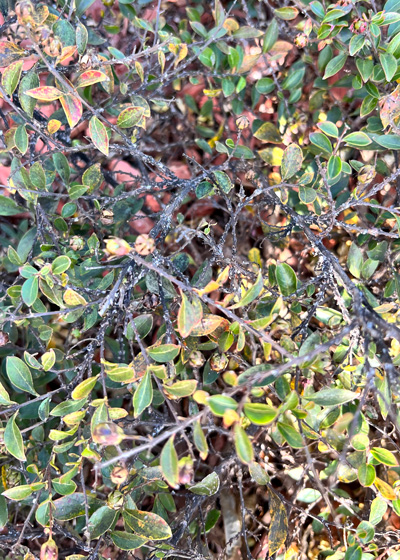
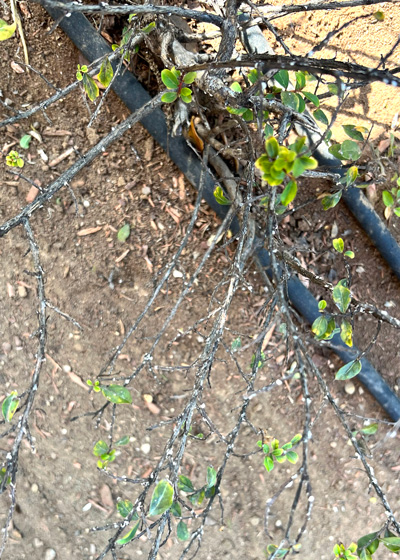
Answer: Many dwarf varieties of crape myrtles were hurt badly by the extreme cold in February 2021. But added to that, your plants are absolutely loaded with crape myrtle bark scale. That’s somewhat unusual for dwarf varieties. You’ll want to apply Imidacloprid systemic insecticide as a soil drench mid-May next spring. It will be taken up through the plants where it will kill the young scale insects as they begin to develop. As bad as these look, however, I have to warn you that it may not be a good investment added onto all the freeze damage.
